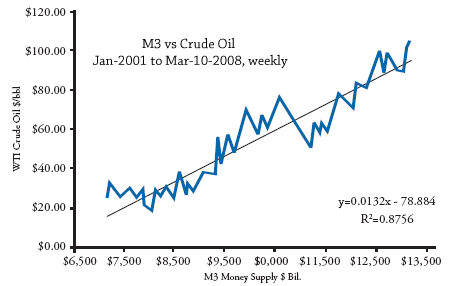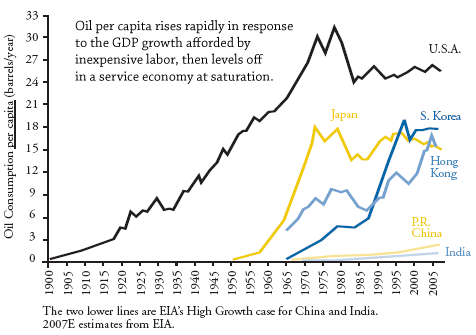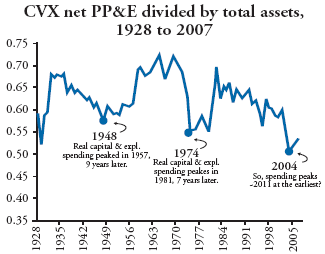| Home | About Us | Resources | Archive | Free Reports | Market Window |
Three Reasons Why The Boom in Oil Services Will ContinueBy
Thursday, April 24, 2008
Has oil hit its peak price or not? The answer to that question leads us to ask whether or not commodities are a bubble about to burst. Barron's recent cover story on commodities came down on the side that the party was over. As an investor, I like to address these key questions, because my Capital & Crisis portfolio is loaded with commodity names – everything from oil and gas to molybdenum and base metals and more. This is by design. I also have the vast bulk of my own money in real, or tangible, assets. When we are not in tangible assets, we are, more frequently than not, on the periphery, in the companies that put together or maintain the vital infrastructure that makes the whole thing go. I believe the charts in this letter contain some powerful insights. You will want to keep them handy when things get rocky. They come courtesy of Barry Bannister, an analyst at Stifel Nicolaus, who delivered an interesting talk in Baltimore recently. We will focus on oil, though a similar story holds true throughout the commodity sector. If you look at the price of oil, you find something interesting. Since January 2001, you can explain the move in the price of oil largely as a function of increasing money supply. As the amount of money grows, the price of oil rises. In fact, almost 87% of the move in the price of oil can be explained by the increase in money supply, as this chart shows:
Basically, $100 per barrel oil is what we would expect to see, given this relationship between the oil price and money supply. Given that we are still in the midst of a credit crisis of sorts, it seems unlikely the Fed will tighten money in any way at all. That leaves a clear path for the price of oil and commodities to continue to rally in nominal terms. The other thing to remember – and people forget this by worrying excessively about a U.S. recession – is that the story of oil is no longer a U.S.-centric story. You've surely heard about how the rapid growth in China and other emerging markets drives oil demand. Well, it's good to keep that in mind. See the chart below: China and India are only beginning to consume oil at any meaningful level.
Right now, they are consuming oil at a rate the U.S. did in the early years of the 20th century. But look, we don't need China to start guzzling oil like we do. Even if it moves half the distance between it and Hong Kong, that's a lot of extra demand. The way I look at it is this: What's more likely, China stays at 1910 oil usage or moves somewhere closer to, say, 1950s U.S. oil usage? I think the latter. All that bodes well for oil demand. So where do you go to make money from all this? The one obvious place people will automatically look to is to own oil and gas producers. That's not a bad idea at all. But I've got another angle here. The next two charts are amazing. They show you the capital and exploration spending of both Exxon (XOM) and Chevron (CVX) from 1928–2007. They show spending bottoms in 1948 and 1974. After each bottom, there was a long run of spending. Spending peaked nine years after 1948. Spending peaked seven years after 1974. If 2005 proves to be the bottom on capital spending – and it seems so, since Exxon only recently announced it would increase its capital spending to $25–30 billion over the next few years, a 25% increase – we won't see capital spending peak until 2012 at the earliest. Take a look. These charts are so similar it is almost eerie...
Now, why is this important? Think about what the oil companies spend money on. Where do they go shopping? They go shopping at the oil field services and equipment companies. So that is where we want to be. Because even if oil has peaked, we're still looking at years of strong spending by the oil companies. You want to have some exposure to the receiving end of all that spending. Such companies will mint cash. As Bannister pointed out, it can sometimes be better to own the picks and shovels. You don't actually own or produce the oil or gas, but your equipment is vital to those that do. He used Newmont Mining, the big gold producer, as an example of a producer that has profoundly disappointed investors amid what may be the greatest gold bull market in history. Newmont's costs rose so fast and so much that it never really enjoyed (at least not so far) the higher price in gold. But if you were in some mining equipment manufacturer, you got paid. So the key takeaways here are these: The price of oil has room to run yet, in part because of the growth in money supply and in part because of pressing international demand. Secondly, even if we already saw oil peak, history says that prices won't retreat by much over the next several years. And finally, the capital spending boom by the big oil companies is just getting started, which is great news for investors in oil field services companies. Good investing,
Further Reading:
My Three Favorite Oil Investments Now Market NotesTHE "REDBACK PUT" IN ACTION
In the late 1990s, the term "Greenspan put" grew famous as an excellent reason to load up on U.S. stocks and real estate.
A "put" acts as portfolio insurance that gains in price if stocks plummet. The Greenspan put became popular because people felt that no matter how bad things got in the market, Fed Chairman Alan Greenspan would lower interest rates, make cheap loans available, and save the day. In other words, government-backed portfolio insurance. Nowadays, something resembling the "Greenspan put" has crept into the commodity markets. You could call it the "Redback put." As you may have read in today's Privy column, the Chinese are shoring up their vast infrastructure plans by plowing billions into the DR Congo's mining industry. The African country has some of the largest untapped metals deposits in the world. China is also in the news for buying big stakes in two of the largest oil producers in the world, Total and BP. It's also looking to own a slice of BHP Billiton, the world's largest diversified commodity producer. We jokingly call China's currency the "Redback." As this chart of copper prices shows, China's mad dash to secure commodities is acting as portfolio insurance for all those who invest in what China needs. |
Recent Articles
|





